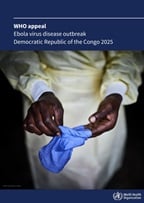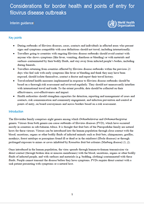Community representatives come to visit a family in the outskirts of Beni to raise awareness about Ebola.
Ebola virus disease
Ebola disease is a severe, often fatal illness affecting humans and other primates.
The virus is transmitted to people from wild animals (such as fruit bats, porcupines and non-human primates) and then spreads in the human population through direct contact with the blood, secretions, organs or other bodily fluids of infected people, and with surfaces and materials (e.g. bedding, clothing) contaminated with these fluids.
The average Ebola disease case fatality rate is around 50%. Case fatality rates have varied from 25–90% in past outbreaks.
The first Ebola disease outbreak occurred in remote villages in Central Africa, near tropical rainforests. The 2014–2016 Ebola virus disease outbreak in West Africa was the largest and most complex Ebola outbreak since the virus was first discovered in 1976. There were more cases and deaths in this outbreak than all others combined. It also spread between countries, starting in Guinea then moving across land borders to Sierra Leone and Liberia.
It is thought that fruit bats of the Pteropodidae family are natural hosts of the orthoebolavirus.
The incubation period, that is, the time interval from infection with the virus to onset of symptoms, is from 2 to 21 days. A person infected with Ebola cannot spread the disease until they develop symptoms.
Symptoms of Ebola disease can be sudden and include: fever, fatigue, malaise, muscle, pain, headache, and sore throat. These are followed by vomiting, diarrhoea, abdominal pain, rash, and symptoms of impaired kidney and liver function. In less frequent cases, internal and external bleeding (e.g. oozing from the gums, blood in the stools), can occur.
It can be difficult to clinically distinguish Ebola from other infectious diseases such as malaria, typhoid fever and meningitis. A range of diagnostic tests have been developed to confirm the presence of the virus.
Early intensive supportive care – rehydration with oral or intravenous fluids – and treatment of specific symptoms improves survival. A range of potential treatments is currently being evaluated.
For Ebola virus disease, WHO recommends treatment with the monoclonal antibodies mAb114 (ansuvimabTM) or REGN-EB3 (InmazebTM). For other Ebola diseases, there are no approved therapeutics, but candidate products are under development and a CORE protocol for clinical trials is available.
Two vaccines have been approved for Ebola disease: Ervebo® and Zabdeno and Mvabea® . The Ervebo vaccine is recommended as part of outbreak response.
Several candidate vaccines are at different stages of development for other Ebola diseases.
Community engagement is key to successfully controlling any outbreak. Outbreak control relies on using a range of interventions, such as clinical care, surveillance and contact tracing, laboratory services, infection prevention and control in health facilities, safe and dignified burials, vaccination (only for Ebola virus disease) and social mobilization.





/r-d-blue-print-(rdb)/cover-page-filovirus-treatments_core-trial-protocol.tmb-144v.jpg?sfvrsn=c4fa6505_2)







